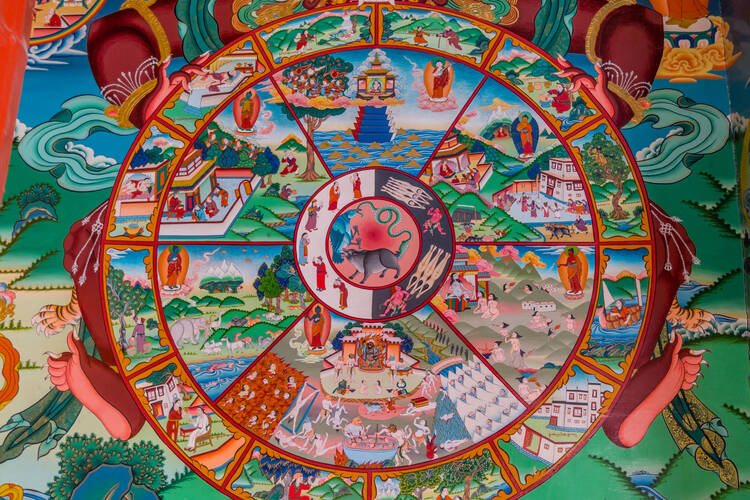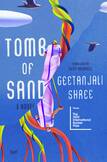Review: Geetanjali Shree’s new novel is one woman’s surprising reincarnation story
Shortly after the end of World War II, religious infighting between Hindus and Muslims broke out on the Indian subcontinent. As episodes of violence became frequent in communities that had lived peacefully together for hundreds of years, the British partitioned the country into two states, India and Pakistan. This decision compelled millions to relocate. Many Hindus migrated to India, and Muslims journeyed to what would become Pakistan and Bangladesh.
Penguin Random House India
725p $19
The partition created fury between the religions, resulting in close to two million deaths and 14 million displaced persons. Historians have compared the carnage to Buchenwald and named it the Holocaust of South Asia. Villages were burned to the ground. Children and the elderly were murdered. About 75,000 young women were tortured and raped.
The butchery on the Indian subcontinent 80-some years ago still affects many who were directly and indirectly involved. It also forms the basis for Geetanjali Shree’s novel Tomb of Sand, whose protagonist, Amma, is tortured but manages to survive.
Numerous authors have written partition novels, short stories, poetry and nonfiction recounting the horrors of this era, including Salman Rushdie, a Muslim, whose novel Midnight’s Children won the 1981 Booker Prize. This year, the prestigious award has come full circle with Geetanjali Shree, a Hindu, winning the 2022 International Booker Prize. Tomb of Sand was translated into English by Daisy Rockwell (granddaughter of Norman Rockwell), who shared the Booker award with Shree.
Tomb of Sand was translated into English by Daisy Rockwell (granddaughter of Norman Rockwell), who shared the Booker award with Shree.
The Hindi title of the book is Ret Samadhi, with ret meaning sand and samadhi having several meanings. Ranging from a deeply meditative state to an ecstatic union with God, samadhi suggests a condition in which the sense of individuality fades away and people realize they share a connectedness to one another. The concept is reminiscent of Teilhard de Chardin’s Omega Point, in which everything in the universe spirals toward unification. That rich spiritual resonance in the original Hindi title is unfortunately lost in Rockwell’s English translation.
On one level, this is a story of an 80-year-old woman named Amma, who, depressed at the death of her second husband, returns to the city of her youth to find her first love, from whom she had been forcibly separated during the British partition.
On another level, this is a reincarnation story featuring a woman who dies and comes back to life—literally and figuratively. She changes from a helpless old woman to someone who seems like a baby, then a toddler, a child, a teenager and an adult.
Toward the end of the story, she rights old wrongs and crosses borders that should have never been imposed. She calls out the insanity of religious prejudice and insists that it is the connections between people that matter.
Much of Shree’s prose is built on puns and cliches. Amma literally has her back against the wall in her bedroom. She figuratively has her back against the wall because she is stuck in a bad position.The cliché, falling through the cracks, is also used literally and figuratively. The same applies to the idea that walls can hear. This is part of her style.
Essentially a fable, the story features Amma, her son, daughter, daughter-in-law and two grandsons, as well as a transvestite friend who appears as both a woman and a man, talking crows that communicate with humans, and a magical cane decorated with butterflies that fly. The cane awakens Amma from her coma and carries her along to hidden places, where she becomes lost.
The most unusual section of the novel occurs at Wagah, a town on the border between India and Pakistan where a lowering-of-the-flags ceremony occurs every day. The ceremony symbolizes both the rivalry and brotherhood of the two nations. What makes this section unusual is that in Shree’s account the audience is composed of the ghosts of dead writers who based their work on the partition.
In the first few pages of the novel, Amma decides that if she were to be hit by a bullet, she would not want to fall face down but rather on her back, reclining regally as if on a soft bed with the sky as her coverlet. And indeed, when a bullet rips through Amma’s body, she does fall on her back and appears to be dead.
The text of Tomb of Sand is packed with figures of speech and sound in the Hindi version—and Rockwell includes these in her translation.
But is she? The plot of this 725-page-novel depends on one’s approach to the question of Amma’s death. And Shree leaves the answer up to us: “Those who consider death to be an ending took this to be hers. But those in the know knew that this was no ending; she’d simply crossed another boundary.” Yet if we follow the clues that Shree provides, it seems as though Amma is reincarnated.
The story enters and exits the minds of this or that character, shifts points of view, blurs identities and muddies chronological order. It weaves a luminous spell reminiscent of a Marc Chagall painting with characters floating in the air.
The narrative contains numerous allusions to the tenets of Hinduism and to the history and geography of the Indian subcontinent, foreign vocabulary, and references to South Asian writers, as well as to political and religious leaders generally unknown in the West. American readers might also struggle with the story’s digressions, wordplay and several unreliable narrators, including one who says “every entry I make here is false” on the book’s final page.
The text is packed with figures of speech and sound in the Hindi version—and Rockwell includes these in her translation. The original story came in at about half the length of the English version. According to Rockwell, the additional pages were necessary to convey the story’s metaphorical quality. She makes a good point, but there are a few too many verbal hijinks here for my taste.
Frank Wynne, chair of this year’s Booker judges, noted that translating Tomb of Sand presented “huge challenges” because the novel is about words, language and storytelling, not just characters and plot. Another judge added that it is “safe to say this [novel] is like nothing else you have ever read.”
True.
This article also appeared in print, under the headline “Like Nothing You’ve Ever Read,” in the July and August 2023, issue.











